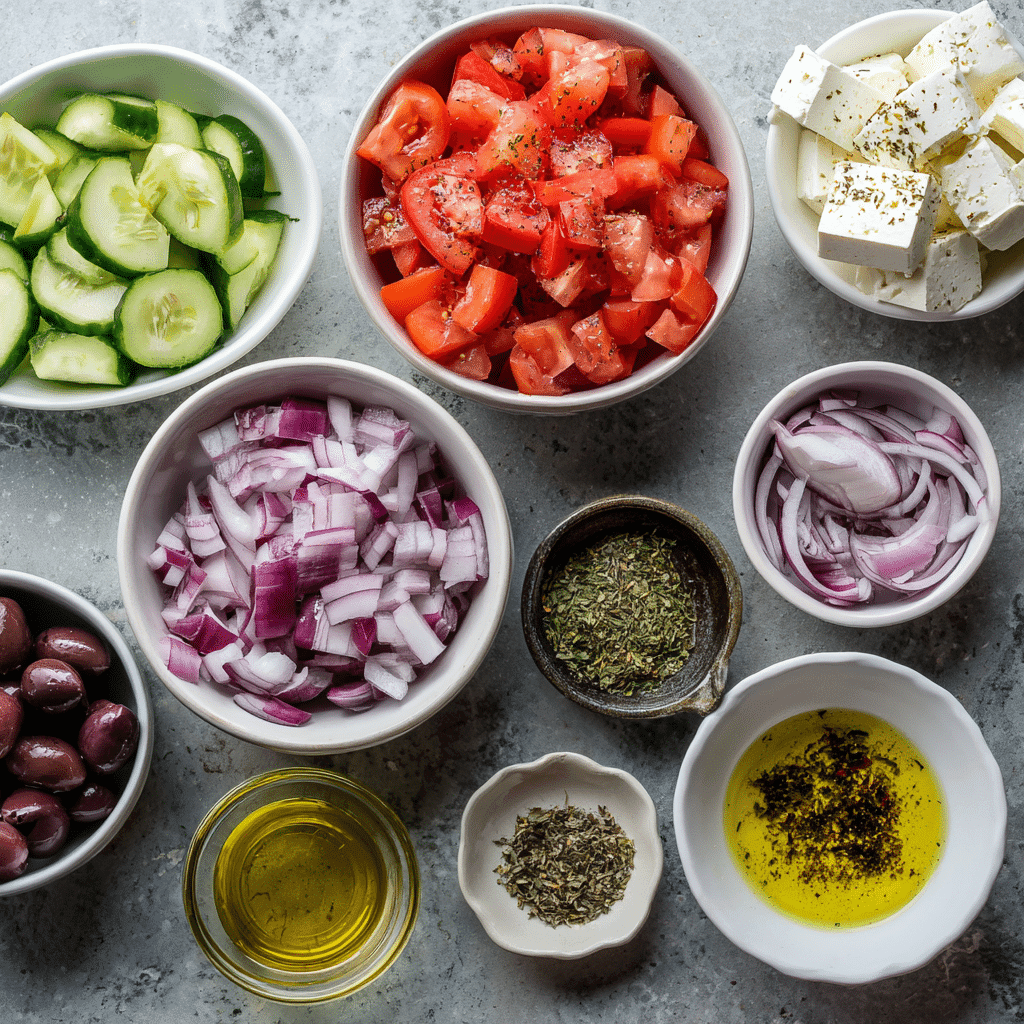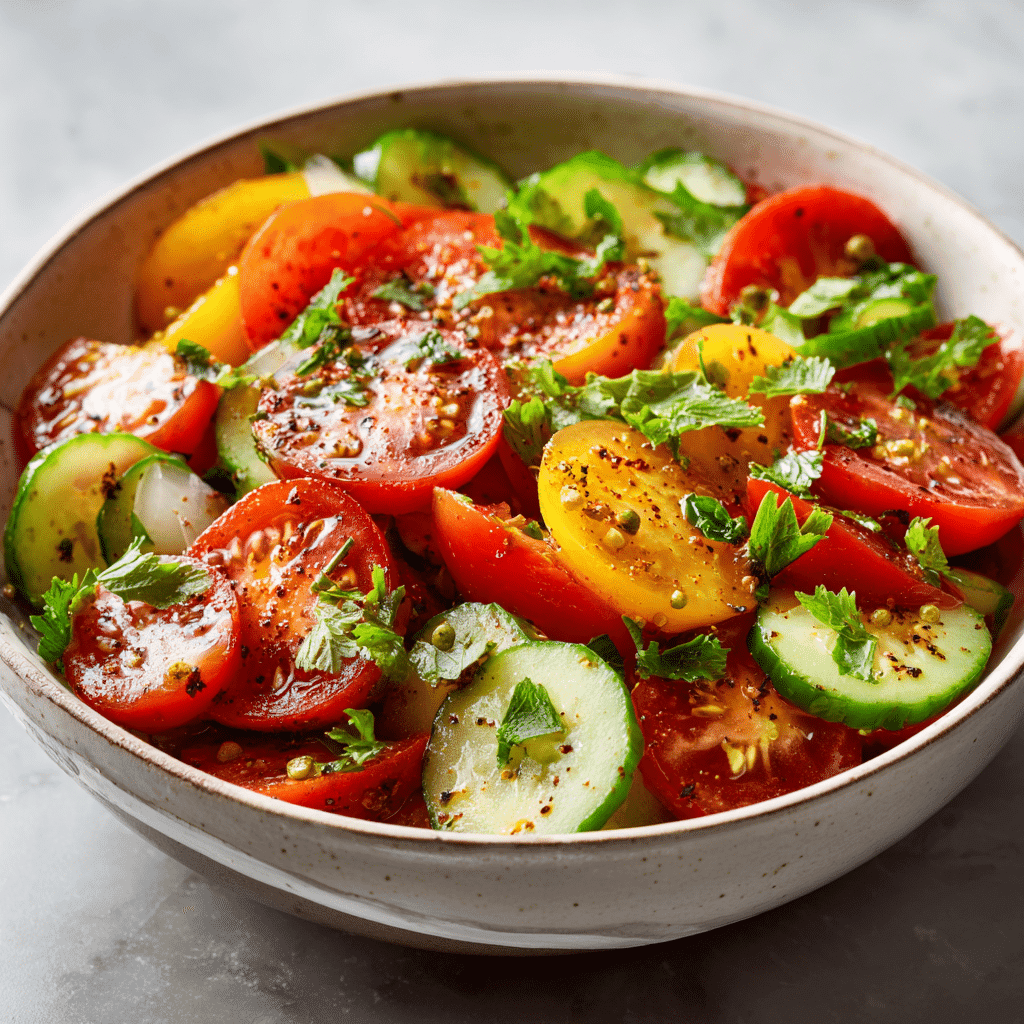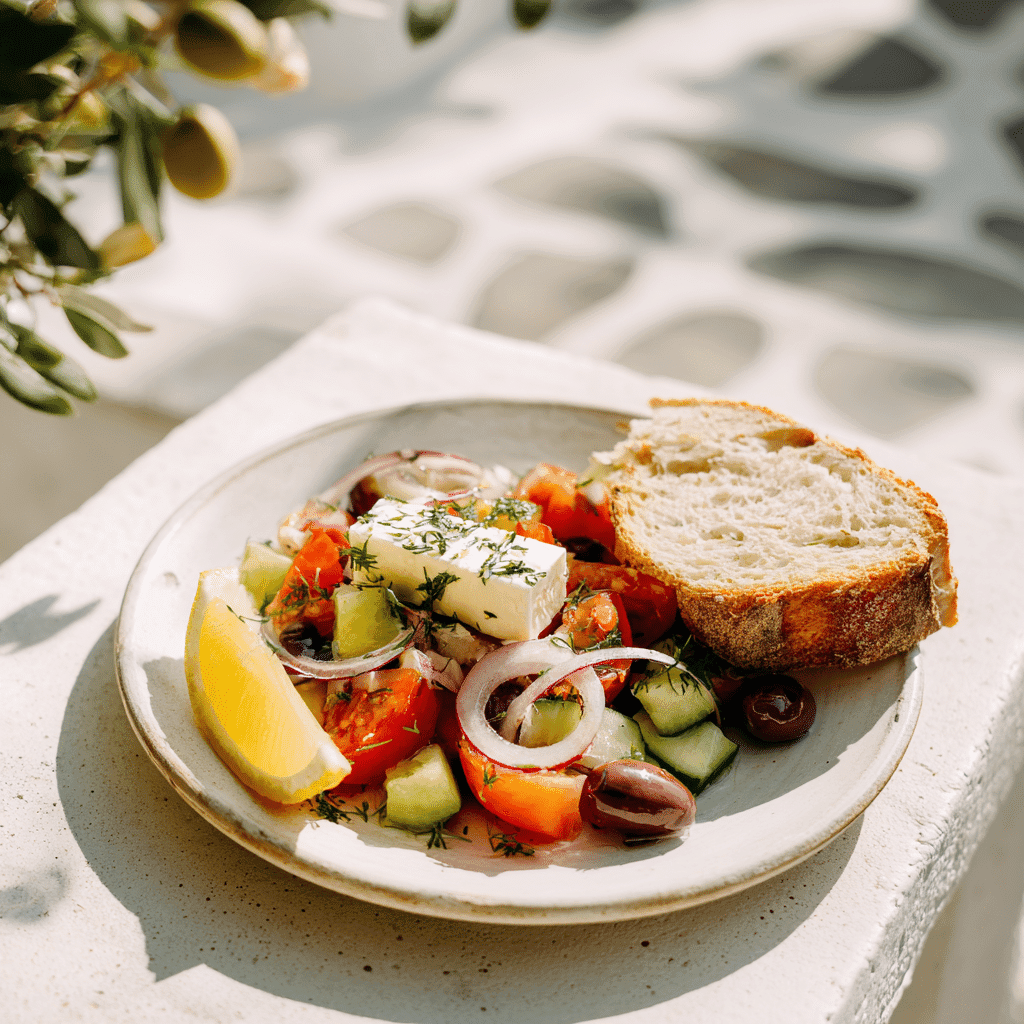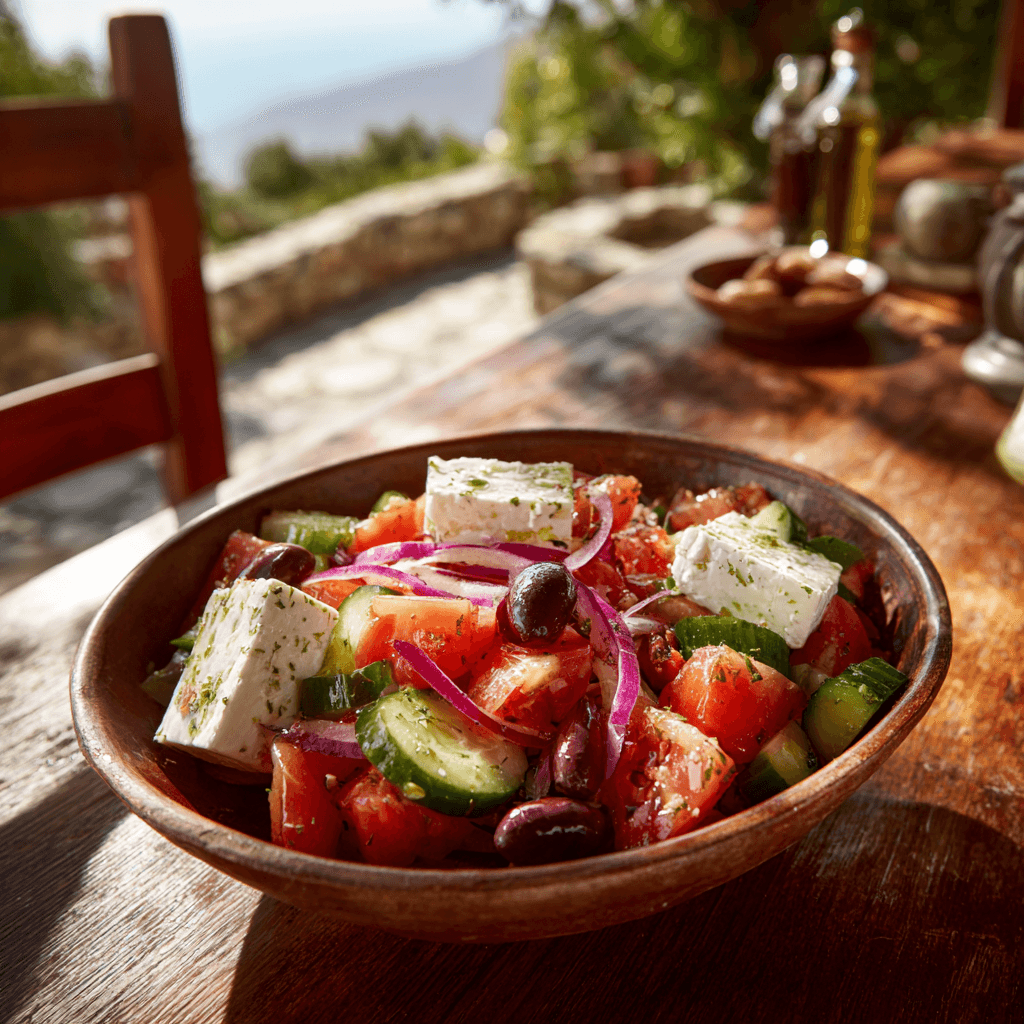Famous Greek salads are more than just side dishes—they’re colorful, wholesome meals that showcase the heart of Mediterranean cooking. Built on ripe tomatoes, crunchy cucumbers, tangy feta, and briny olives, these salads celebrate balance and simplicity. In this guide, you’ll discover traditional favorites like horiatiki, along with a few creative takes that bring bold flavor to your everyday meals. Whether you’re craving something classic or something new, these Greek salad recipes deliver a satisfying bite of sunshine in every forkful.
Table of Contents
1: The Story & Intro
Why Famous Greek Salads Feel Like Home
Famous Greek salads have a way of feeling like comfort food, even if you’ve never been to Greece. For me, that connection started in my grandmother’s small kitchen, where fresh ingredients always came first. She didn’t call it horiatiki, but her tomato, cucumber, and feta salad had all the flavors you’d find in a seaside Greek taverna. Everything was simple, but every bite was full of joy. That’s the heart of what makes these salads so special.
The first time I tasted an authentic Greek salad on Greek soil, it took me right back to her table. I remember sitting at a café in Nafplio, the sea breeze brushing past, eating a bowl of ripe tomatoes, Kalamata olives, and creamy feta over crisp cucumbers—all dressed in golden olive oil and dried oregano. No lettuce, no dressing from a bottle, just bold, honest flavors. That memory stays with me to this day.
What makes famous Greek salads stand out isn’t complexity—it’s their confidence in fresh, bold ingredients. That’s the same mindset I bring to my own cooking and to recipes like this easy vegetarian feta potato salad that layers creaminess and tang in every bite. Or this watermelon feta salad with balsamic, which puts a summery twist on a classic Greek flavor pairing.
Through this article, I’ll walk you through the most well-known Greek salads, the ingredients that define them, and creative ways to enjoy them year-round. Whether you’re just getting into Mediterranean cooking or looking for a fresh way to serve up produce, these famous Greek salads belong on your table.
Print
Famous Greek Salads
- Total Time: 10 minutes
- Yield: 4 servings
- Diet: Vegetarian
Description
Colorful, wholesome, and rooted in Mediterranean tradition, famous Greek salads like horiatiki bring bold flavors to your table with minimal ingredients and maximum impact.
Ingredients
- Ripe tomatoes (cut into wedges or chunks)
- Cucumbers (sliced, peeled optional)
- Red onions (thinly sliced)
- Kalamata olives (pitted)
- Greek feta cheese (block form preferred)
- Extra virgin olive oil
- Red wine vinegar
- Dried oregano
- Sea salt and black pepper (optional)
Instructions
- Place tomato chunks, cucumber slices, and red onion into a serving bowl.
- Add Kalamata olives and place a slab of feta cheese on top.
- Drizzle generously with olive oil and a splash of red wine vinegar.
- Sprinkle dried oregano over the top and season with salt and pepper if desired.
- Do not toss—serve as is for a rustic, layered presentation.
- Optional: serve with crusty bread or pita to soak up juices.
Notes
Use the freshest ingredients available. Authentic Greek feta (made from sheep’s milk) gives the best flavor. For modern twists, try adding watermelon, avocado, or serving it deconstructed as a mezze platter.
- Prep Time: 10 minutes
- Cook Time: 0 minutes
- Category: Salad
- Method: No-Cook
- Cuisine: Greek
2: Ingredients & Regional Variations

The Staples Behind Famous Greek Salads
The building blocks of famous Greek salads are refreshingly simple, but each ingredient plays a big role. The most recognizable version is the horiatiki, or village salad, known for combining juicy tomatoes, cucumbers, red onions, olives, and thick slices of Greek feta cheese. These elements come alive when drizzled with olive oil and sprinkled with oregano. There’s no lettuce in sight—because this dish relies on bold flavors, not filler.
Real Greek feta makes all the difference. If you’ve only tried the crumbly, dry kind from plastic tubs, it’s time for an upgrade. Authentic feta, often made from sheep’s milk, has a creamy texture and distinct tang that balances the acidity of tomatoes and vinegar. This creamy saltiness is the signature contrast that defines famous Greek salads around the world.
A touch of sea salt and fresh-ground pepper may be added, but that’s optional. The balance comes naturally when the produce is fresh. And that’s the secret: quality over quantity. It’s not about piling on ingredients—it’s about celebrating what’s in season.
Salads inspired by Greece often make thoughtful additions. You might find green bell peppers, fresh parsley, or even avocado slices in modern versions. A good example of creative Mediterranean influence is this fresh burrata salad recipe, which takes the creamy cheese concept in a delicious direction. Or check out this crispy rice salad, which plays with texture but stays rooted in traditional flavor profiles.
Regional Variations of Famous Greek Salads
While the core ingredients are consistent, famous Greek salads vary from region to region. On Crete, there’s dakos—a salad served over crunchy barley rusks, topped with chopped tomatoes, fresh herbs, and mizithra cheese instead of feta. The result is still vibrant and balanced, just with a Cretan twist.
In Santorini, the local cherry tomatoes bring a slightly sweeter flavor. Some islands introduce capers, arugula, or wild greens to bring a peppery kick. In Naxos, they might use a local cow’s milk cheese to replace feta. Even the way vegetables are chopped changes: some villages serve the salad chunky, others finely sliced.
These small shifts highlight how famous Greek salads reflect local farming and personal taste. You could even say each bowl tells a story. And when these salads are paired with crusty bread or rustic grain bases, they become full meals—just like this vegetarian feta potato salad, which offers a satisfying spin on traditional textures.
These salads continue to evolve while staying true to Greek values: simplicity, seasonality, and the joy of sharing good food. Whether you stick to the original horiatiki or play with modern ingredients, you’re still enjoying one of the world’s most beloved dishes.
In the next section, we’ll cover how to easily assemble famous Greek salads at home and offer some popular serving ideas that bring them to life.

3: Easy Assembly & Modern Twists
How to Assemble Famous Greek Salads Like a Local
Assembling famous Greek salads might be one of the easiest things you’ll ever do in the kitchen—and that’s exactly why they’re so appealing. No complicated techniques. No fancy tools. Just fresh, bold ingredients arranged with care.
Start by cutting ripe tomatoes into wedges or chunks. Slice cucumbers (peeled or unpeeled—your call) and thinly slice red onions. Add pitted Kalamata olives and a big slab of feta on top. Drizzle with olive oil—don’t be shy here—and add a splash of red wine vinegar. Sprinkle everything with dried oregano. Done.
Don’t toss the salad. That’s a common mistake. Instead, serve it with all the ingredients layered or loosely combined, letting the juices mingle naturally on the plate. This rustic style respects the integrity of each element. If you’re serving guests, bring it to the table as is—they’ll appreciate the beauty in its simplicity.
For extra flavor, you can rub a garlic clove around the bowl before assembling. Or serve it with toasted bread to soak up the olive oil and tomato juices, turning the salad into a full meal.
This no-fuss process is a great entry point for anyone wanting to embrace Mediterranean cooking. For inspiration, check out how it’s done in this refreshing peach nectarine salad recipe, where sweet stone fruits offer a sunny, Greek-style twist.
Modern Twists on Famous Greek Salads
Even the most famous Greek salads can evolve without losing their soul. Many cooks today add creative elements while preserving the dish’s heart. You might see grilled zucchini, quinoa, chickpeas, or even fresh herbs like dill or mint mixed in for more texture and flavor.
One trend is combining fruit with traditional ingredients. Watermelon, grapes, or oranges pair surprisingly well with salty feta and olives. The balance of sweet and savory brings depth—and it’s especially popular in summer months. This watermelon feta salad with balsamic is the perfect example, showcasing a light yet punchy combination that still honors the Greek flavor profile.
Another fun twist? Serve your Greek salad deconstructed as a mezze platter. Place each component—feta, tomatoes, cucumbers, olives—on a wooden board and let guests build their own bites. It’s interactive, visually appealing, and ideal for gatherings.
If you’re watching carbs or want a lighter dinner option, try turning the salad into lettuce wraps using butter lettuce leaves as a base. You still get all the Mediterranean flavor but in a modern, handheld form.
No matter how you serve it, the core of famous Greek salads always shines through. That’s the beauty—they’re flexible but never forget where they came from.
4: Serving Ideas & Year-Round Enjoyment

How to Serve Famous Greek Salads for Any Occasion
One of the best things about famous Greek salads is how effortlessly they fit into any meal. Whether you’re hosting a backyard lunch, prepping a quick weekday dinner, or bringing something to a potluck, a Greek salad never feels out of place.
In summer, serve it chilled with grilled lamb or chicken. The acidity from tomatoes and vinegar, paired with the creamy feta, cuts through the richness of grilled meats perfectly. Add a side of crusty bread or pita and you’ve got a satisfying Mediterranean feast with minimal effort.
If you’re planning a brunch spread, a Greek salad adds freshness and color next to egg dishes and pastries. Try including it in a build-your-own salad bar with add-ons like chickpeas, capers, artichoke hearts, or even some pickled onions.
Want something heartier? Layer it over grains or roasted vegetables. The creamy base of this air fryer gnocchi salad shows how easily Mediterranean flavors adapt to modern meals. Or serve it alongside a tangy, colorful dish like this ribbon carrot salad for a vibrant, plant-forward table.
Enjoying Famous Greek Salads Year-Round
While tomatoes and cucumbers are summer stars, famous Greek salads can easily transition into other seasons. In fall and winter, try roasting vegetables like beets, carrots, or sweet potatoes and serving them warm with feta and olives. Add a drizzle of olive oil and lemon juice for a seasonal version that still feels authentically Greek.
You can also experiment with legumes, such as lentils or white beans, to make the dish more filling during cooler months. Swap in sun-dried tomatoes when fresh ones aren’t at their peak, and use preserved lemons for a bright, citrusy punch.
Greek cuisine is rooted in practicality—cooking with what’s available, making it shine, and sharing it with people you care about. That’s why these salads endure. Whether you’re spooning up juicy tomatoes in July or layering roasted squash in November, the spirit of famous Greek salads stays the same.
And remember: the magic of these dishes lies in their simplicity. So don’t overthink it. Choose fresh ingredients, dress them well, and enjoy every bite.
5: Conclusion: Why Famous Greek Salads Deserve a Spot on Your Table
Famous Greek salads aren’t just recipes—they’re a celebration of simplicity, freshness, and the joy of sharing good food. Whether you’re slicing tomatoes in the heat of summer or adding roasted veggies in the colder months, the flavors stay timeless. These salads work as starters, sides, or even the star of the meal, all without complicated prep or long ingredient lists.
From the classic horiatiki to creative versions with fruit, grains, or herbs, Greek salads offer something for every taste. Their appeal lies in their honesty: real ingredients, bold flavors, and a connection to tradition that feels just as welcome at a backyard cookout as it does at a weeknight dinner.
What salads are popular in Greece?
The most popular salads in Greece include the classic horiatiki (village salad), dakos from Crete, and maroulosalata, a green lettuce-based salad. These salads often feature fresh tomatoes, cucumbers, olives, feta cheese, olive oil, and herbs. Variations might include peppers, capers, or local cheeses, depending on the region.
What is the most traditional Greek salad?
The most traditional Greek salad is horiatiki, which includes tomatoes, cucumbers, red onion, Kalamata olives, and a slab of feta cheese, dressed with olive oil and oregano. It’s typically served without lettuce and reflects the rustic, no-fuss cooking style of rural Greek kitchens.
What is a Greek theme salad?
A Greek theme salad refers to any salad inspired by the key flavors of Greek cuisine—usually including feta, olives, tomatoes, cucumbers, and olive oil. It can be a twist on the original, like adding grains, grilled chicken, or dressing it with lemon and garlic for extra Mediterranean flair.
What are the most famous salads?
Globally, the most famous salads include Caesar salad, Cobb salad, Niçoise, Caprese, and of course, famous Greek salads like horiatiki. Greek salads stand out for their bold flavor and simple, fresh ingredients, making them a worldwide favorite for warm-weather meals.
What is a traditional green salad in Greece?
A traditional green salad in Greece is called maroulosalata. It’s made with shredded romaine lettuce, scallions, dill, olive oil, and lemon juice or vinegar. It’s lighter than horiatiki but just as flavorful and is often served alongside grilled meats or seafood.

